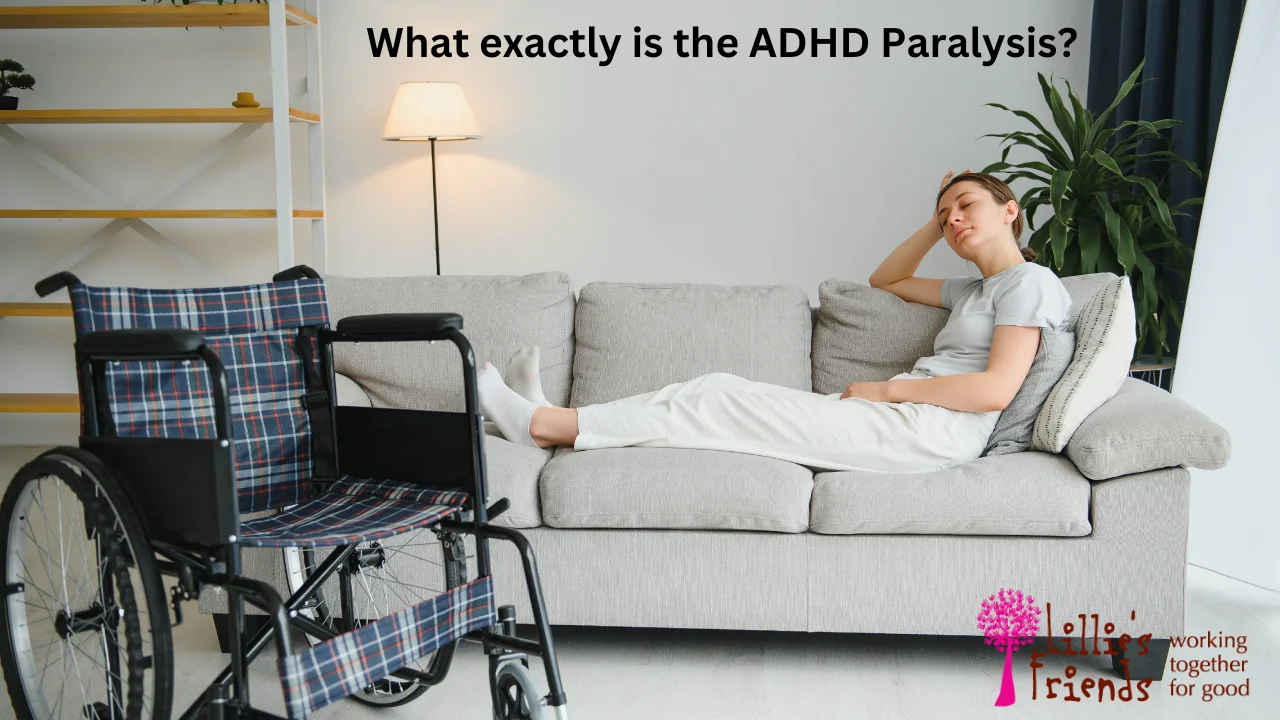Highlights
- ADHD paralysis, also known as ADHD freeze, ADHD shutdown, or analysis paralysis, can result from a combination of the freeze stress response and executive dysfunction associated with ADHD in the brain.
- Self-help methods are the most popular means of treating ADHD paralysis, but in certain situations, a medical professional might suggest behavioral therapy or medication.
- Distinguishing between procrastination, depression symptoms, and ADHD paralysis is crucial. See a mental health professional if you have trouble describing what you are going through.
It is Friday night. You’re sitting on the floor, frozen and overwhelmed, staring at the roast in the oven when you should be anticipating your friends’ arrival for dinner. You neglected to buy dessert, didn’t get the kids to clean the restroom, and missed your work deadline today. It’s all too much, and your guests will be here in five minutes.
Simple tasks may seem impossible to complete due to ADHD paralysis, and a pile of unfinished business can leave you feeling overburdened. Continue reading to learn how to take charge of your thoughts in circumstances similar to the one depicted above!
ADHD Paralysis: What Is It?
People with attention deficit hyperactivity disorder use the term “ADHD paralysis” to describe the state in which they feel so overwhelmed that they freeze or shut down; it is neither a medical diagnosis nor a term used in clinical practice.
“A behavioral disorder known as attention deficit hyperactivity disorder, or ADHD, makes it difficult to focus on daily tasks and routines.” The American Psychiatric Association ↗ explains the diagnosis and suggests the cause of ADHD paralysis as follows: Difficulty focusing and staying on task is caused by inattention and high distractibility.
Physical or mental (cognitive) overload is the ultimate result of poor focus. As a result, an adult with ADHD paralysis begins to feel physically or mentally immobilized, unable to make decisions, and unable to begin or complete even basic tasks.

Why Does ADHD Paralysis Occur?
Let’s examine science. It is thought that the following series of events leads to ADHD paralysis:
- First, there are executive function issues in the brain.
- Next, the stress response assumes control.
What does this signify?
Executive dysfunction and poor working memory ↗ are well-known symptoms of ADHD. Therefore, the brain is strained by increased sensory input and the need to remember many things at once, which makes it difficult to focus, prioritize tasks, or make logical decisions. This sets off the stress response and causes a variety of overwhelming emotions, especially anxiety. Can you recall the fight-or-flight response? The third “F” is, well, FREEZE.
Therefore, ADHD paralysis may be brought on by a combination of poor executive functioning and the “freeze” stress response, which leaves you immobilized and unable to decide what to do or where to start.
Paralysis symptoms of ADHD
Despite the fact that each person experiences ADHD paralysis differently, the following symptoms may be familiar to you:
- Brain fog: Inability to organize thoughts, mental haziness, or lack of clarity.
- Exhaustion: A burnout cycle may arise from ADHD paralysis. Accordingly, more stress leads to weariness, which in turn leads to more stress and ongoing fatigue.
- Brain crash or freeze: Brief mental “blankness” or lapses in concentration that disrupt cognitive function.
- Emotional outbursts: Emotional instability and abrupt mood swings are possible.
- Hyperfocus: This may seem contradictory at first. Isn’t inability to focus a sign of ADHD? However, individuals who suffer from ADHD paralysis may choose to focus on a single task rather than completing all of their other responsibilities as a coping mechanism.
ADHD Paralysis Types
The following particular symptom areas aid in identifying the various forms of ADHD paralysis:
- ADHD mental paralysis: This phrase refers to mental fog, which can replace choice or task paralysis and impair one’s capacity for efficient and clear thought.
- ADHD task paralysis: Inability to concentrate makes it difficult to begin or finish tasks, particularly those that are difficult or complex. A person with ADHD starts to procrastinate ↗ and feels powerless.
- ADHD choice paralysis: Sometimes called decision paralysis or analytical paralysis. Too many options make one feel overwhelmed and without direction; overthinking takes control.
Procrastination vs. Depression vs. ADHD Paralysis
Although procrastination is not a medical term, ADHD and depression are two different diagnoses. It is a deliberate and needless postponement of beginning or finishing a task, even when one is aware of the negative effects of the choice. While occasional procrastination is normal, it may be the result of extreme stress or a mental health issue like depression or ADHD if it occurs frequently or negatively impacts social interactions and day-to-day functioning.
It may be unclear whether apparent procrastination is caused by depression or ADHD paralysis; let’s examine the distinctions:
- Poor focus, impulsivity, and other ADHD diagnostic symptoms can cause ADHD paralysis, a stress-related “freeze” state.
- Depression symptoms such as extended sadness, emptiness, hopelessness, worthlessness, guilt, and loss of interest in activities lead to indecision and apathy.
Depression is actually a common condition among people with ADHD; it makes sense that if you are struggling at work and at home, your mood will eventually deteriorate and you may feel hopeless. In order to make an accurate diagnosis and treat both conditions at the same time, it is crucial to undergo a thorough mental health evaluation.
What Is the Duration of ADHD Paralysis?
Unfortunately, since every situation is different, it is impossible to predict this. The following are some variables that impact how long an episode lasts:
- The degree to which the individual’s ADHD is managed
- Their degree of stress
- Conditions at home and at work
You need to be highly resilient if you want to quickly overcome the paralysis caused by ADHD. It is essential to cultivate effective coping mechanisms and, when required, seek professional therapeutic interventions.
Ways to Break Free from ADHD Paralysis
Here is a useful to-do list of self-help strategies to get you started if you want to avoid and manage ADHD paralysis yourself:
- Follow your passions: Scheduling enjoyable activities can boost motivation and overall well-being, especially when you’re feeling overburdened.
- Make your work schedule easier by using a calendar or diary that has specific times for work and breaks. Better time management and organization will make it less necessary to remember too many things at once and instead allow you to go through each one individually.
- Take breaks: Taking regular pauses helps avoid mental fatigue.
- Divide work into manageable chunks: Complicated projects can be intimidating, so dividing them up makes it easier to get started and boosts output.
- Reduce digital overstimulation: You must establish boundaries because digital gadgets can be a major source of distraction. Turn off pointless alerts, use “do not disturb” features, and maintain focus.
- Eat a balanced diet: Managing symptoms of ADHD requires proper nutrition, particularly if you are taking medication that may make you less hungry.
- Seek support: You can do this by joining support groups within the ADHD community or by consulting with an ADHD coach. Being around people who have gone through similar things can help you become more self-aware and provide the understanding and social connections you need.
- Go for regular walks: Exercise helps control symptoms of ADHD and enhance cognitive function ↗. Plan to take a 30-minute walk during the day and switch up your surroundings to help you focus when you return.
- Put your feelings on paper: This technique, also known as a brain dump, aids in the processing and understanding of emotions.
- Get professional assistance: If self-help methods aren’t working for you and your everyday life is being severely disrupted by ADHD paralysis or other symptoms, you might need to see a healthcare provider for guidance and treatment.
ADHD Paralysis’s Impact on Everyday Life
You might find yourself sitting around with your everyday life collapsing because you are unable to prioritize, take action, or connect. You risk missing opportunities, wasting valuable time overanalyzing even the most basic issues, and experiencing guilt and shame, which can lead to a vicious cycle. Despite the fact that it may appear challenging, ADHD can be managed with expert assistance. You can get individualized support to help you overcome obstacles and improve your everyday functioning from the comfort of your home with online ADHD treatment.
Shame Concerning ADHD Immobility
People who unfairly judge patients with ADHD based on misconceptions about their diagnosis frequently cause public stigma around the disorder ↗. One consequence of this could be self-shame. This indicates that individuals with ADHD internalize and take for granted that unfavorable public opinion.
For instance, after observing an episode of ADHD paralysis at work, coworkers of individuals with ADHD might share a story with friends or family. This could give the impression that people with ADHD aren’t able to work well with others, which would lead to prejudice. Conversely, self-stigma emerges when an individual with ADHD accepts the rumor that they cannot positively impact their profession.
How to Get Help from Lillie’s Friends to Get Past ADHD Paralysis
Lillie’s Friends is available to assist you if you observe that your everyday life is negatively impacted by ADHD paralysis. You can visit a medical expert who specializes in treating ADHD, undergo a thorough evaluation, and receive tailored advice and care.
A click away is guidance, a precise diagnosis, and useful recommendations!
FAQ
What is ADHD task paralysis?
You may have attention deficit hyperactivity disorder (ADHD) task paralysis if you struggle to begin or complete tasks, feel overwhelmed, and are unable to act. Executive dysfunction, sensory overload, and the ensuing stress response are the causes of ADHD paralysis.
How do I get out of ADHD task paralysis?
You can get over the paralysis caused by ADHD. Self-help strategies like segmenting difficult tasks into manageable chunks, planning breaks, reducing distractions, and making sure you get enough exercise can be your starting point. However, it is recommended to seek professional assistance if the symptoms do not improve.
What does ADHD paralysis feel like?
Despite their desire or intention, patients with ADHD paralysis may appear physically or mentally stuck, unable to start or finish tasks. Anger, worry, anxiety, feeling overworked, or even depression could be the outcome.
Can you have task paralysis and not have ADHD?
Indeed, people without ADHD can occasionally experience task paralysis. Anyone who lacks effective coping mechanisms or is faced with a large number of complex tasks may experience it. However, compared to the general population, task paralysis is more common and severe in people with ADHD.
What is an ADHD shutdown?
A form of ADHD paralysis known as an ADHD shutdown occurs when individuals with the disorder feel exhausted and mentally or emotionally paralyzed, typically as a result of the burnout cycle. Exhaustion brought on by stress can lead to further stress, which in turn leads to further exhaustion and eventual shutdown.
Does ADHD cause mental blocks?
ADHD can lead to mental blocks in the form of an inability to focus, make decisions, or concentrate on anything because it can impact executive function, which includes working memory and many cognitive processes.
Does ADHD cause decision paralysis?
ADHD can lead to decision paralysis if left untreated and unmanaged. Perfectionism and poor prioritization can also contribute to this. See a mental health professional to determine whether your inability to make decisions or mental fog is due to ADHD.
What is time paralysis in ADHD?
People with paralysis may have trouble accurately estimating timeframes or feel as though time is passing them by. It can be difficult for people with ADHD to stay organized and meet deadlines because they usually struggle with time management.











